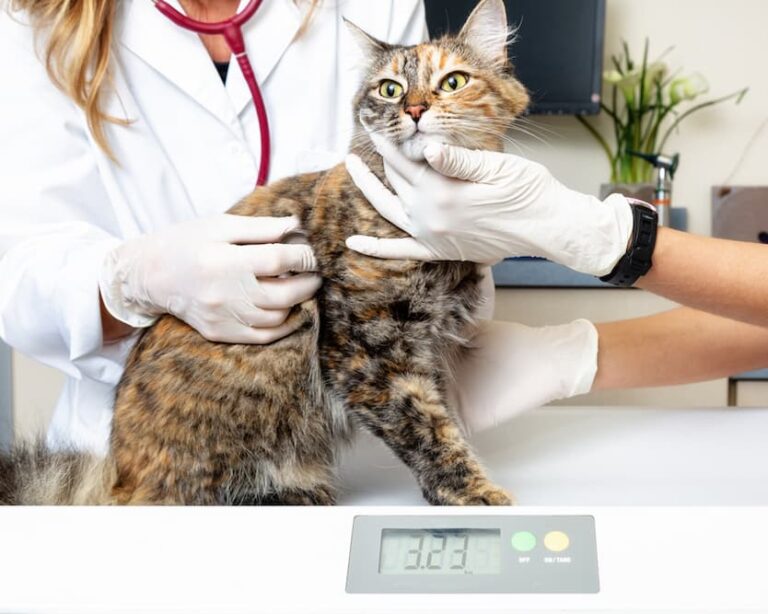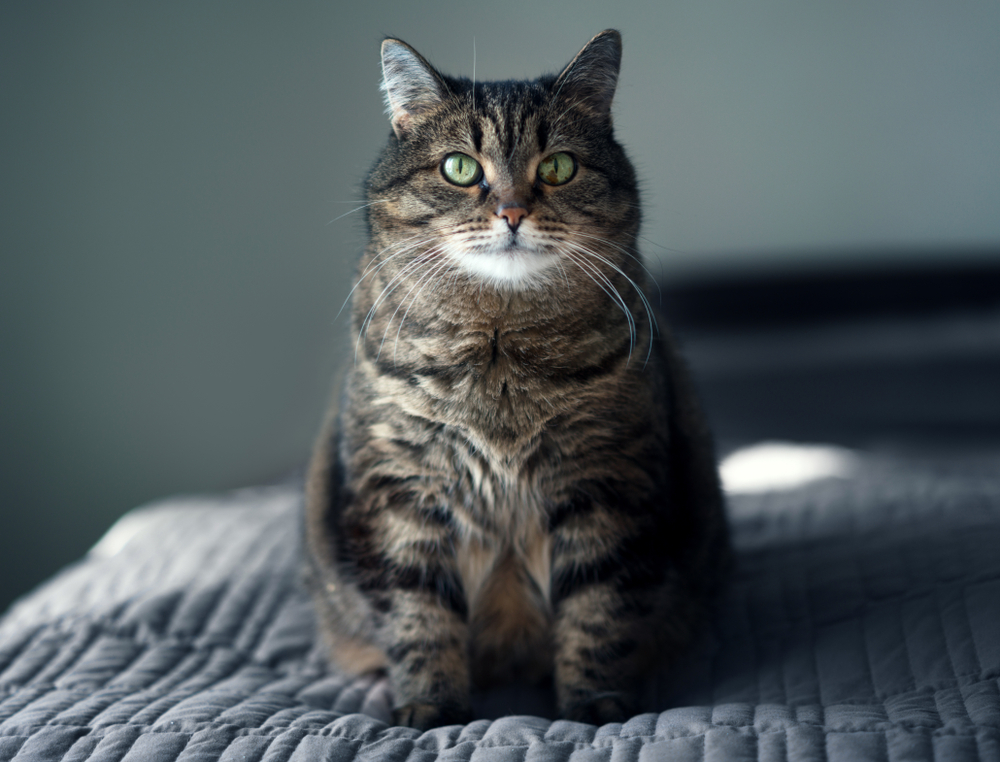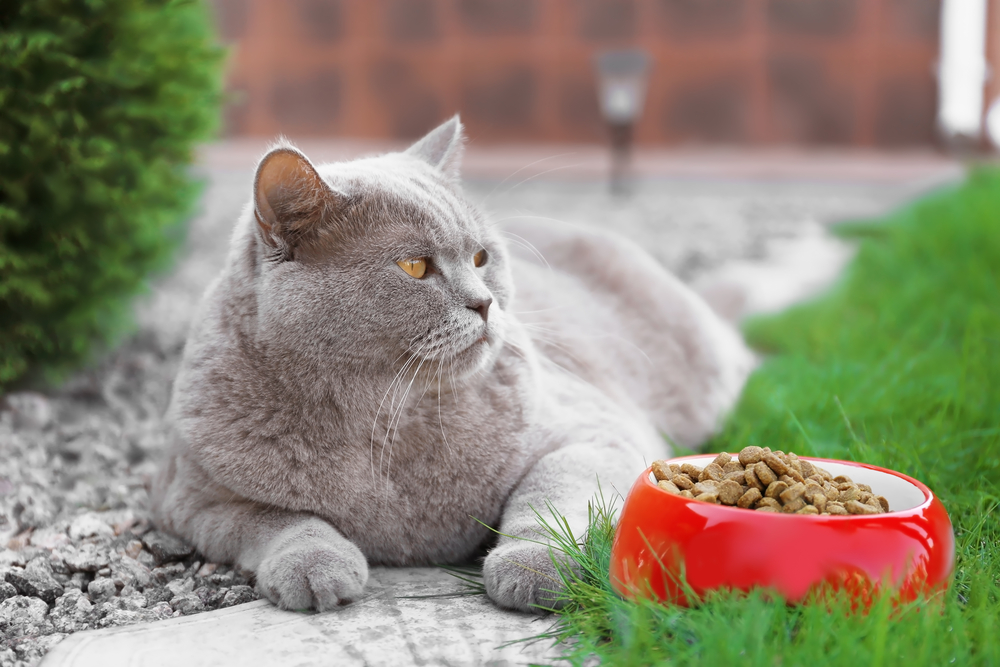Cat Body Condition Score: How to Measure It

Do you have a furry feline who’s earned the nickname Chonksaurus Max? (Other aliases may include Big Boi, Jelly Roll, Marshmallow Fluff, or — as I like to call my cat — Speed Potato.) Or perhaps you are the loving pet parent of a Slim Jim or Skinny Minnie kitty. In either case, a cat body condition score can be a valuable tool when it comes to helping your feline friend achieve and maintain a healthy weight.
Here’s a helpful overview covering everything pet parents need to know about body condition scores for cats, regardless of where your pet lands on the weight spectrum. Find out exactly what a cat body condition score is, how to measure it, and how it can help you manage your cat’s weight and overall health.
What is a Cat Body Condition Score?

Let’s start with the basics. Much like a Body Mass Index (BMI) score for humans, a Body Condition Score (BCS) offers an easy way of understanding whether an animal is underweight, ideal weight, overweight, or obese.
The BCS technique was originally developed as a way to help farmers monitor the weight of their livestock. However, body condition scoring was later adapted for use in companion animals to raise awareness about pet obesity and its associated health risks.
For pets, this handy tool works by assessing a dog’s or cat’s body weight in relation to their size. That assessment then translates into a score on a numeric scale that shows how close (or far) they are from the ideal body condition for cats.
Body condition scores for cats typically range from 1-9.
- If your cat scores between 1-3, they are considered underweight
- Cats that score 4-5 are considered ideal weight
- Cats that score 6-7 are overweight
- Cats that score 8-9 are obese
Carrying a few extra pounds might not seem like a big deal. But cats who are overweight or obese face higher risks of various health issues, including diabetes mellitus, arthritis, kidney disease, heart disease, and others. And underweight cats are not in the clear, either. Weight loss or low weight can sometimes be a warning sign of serious health conditions in cats, such as hyperthyroidism.
Keeping track of your cat’s BCS plays an important part in helping your cat maintain a healthy weight. It can also alert you to weight changes that could easily go unnoticed, so you can act quickly to address any underlying health concerns.
Cat BCS vs. BMI
If you’re wondering what the difference is between BCS and BMI, and if one is more reliable than the other, here’s the scoop. While both a cat’s BCS and a human’s BMI are assessments of body weight, how and what we measure to determine these numbers differs significantly.
To determine a cat’s BCS, we assess their body weight, body fat, and lean muscle mass by observing and palpating certain areas of their body. Then we compare what we see and feel to established body condition standards to obtain a number known as the BCS.
By contrast, physicians typically calculate BMI in humans by dividing a person’s weight by a square of their height to obtain a rough estimate of their body fat. However, this calculation does not differentiate between muscle and fat — a distinction that has a big impact on the type of diet or exercise a veterinarian might recommend to help a cat live a long, healthy life.
How to Measure Your Cat’s Body Condition Score

Every year, your veterinarian will evaluate your cat’s body condition score during their annual exam. But there’s no reason to wait until your pet’s checkup to learn whether their score has changed.
Measuring your cat’s body condition score is easy to do at home, too. And while this should never replace yearly assessments conducted by a trained veterinary pro, checking your cat’s BCS regularly can help you stay on top of weight changes before they become bigger issues.
Here’s how to measure your cat’s body condition score:
1. To guide your assessment, you may want to reference a Cat Body Condition Score Chart that shows you exactly what you’re looking for.
2. You’ll need to observe and gently feel parts of your cat’s body. So it’s best to conduct your assessment when they’re feeling calm and cooperative.
3. Start by looking down at your cat from above to detect the shape of their silhouette.
- An underweight cat (BCS 1-3) will have a distinct hourglass shape, with noticeable narrowing at the waist. You might even be able to see their spine and ribs visible beneath their coat.
- A cat with an ideal shape (BCS 4-5) will have a well-proportioned hourglass silhouette with subtle indentations at the waist.
- In an overweight cat (BCS 6-7), the waistline might be difficult to detect at all.
- And in an obese cat (BCS 8-9), the waist bulges out instead of in.
4. Next, gently run your fingers from the front of your cat’s ribcage to the back, being careful not to apply too much pressure. Then run your fingers along their spine. Finally, palpate (gently press) the abdomen area.
- In an underweight cat (BCS 1-3), the ribcage, spine, and pelvic bones may jut out sharply. Not only will the bones be easy to feel under the skin, but they may even be highly visible from a distance.
- In a cat with an ideal shape (BCS 4-5), you will still be able to feel the ribs and spine, but just beneath a thin cushion of body fat. The abdomen will feel taut, but not squishy.
- In an overweight cat (BCS 6-7), it will be difficult (but not impossible) to feel the ribs beneath the fat layer. The abdomen will hang down a bit, so it’s equal with the ribcage.
- And in an obese cat (BCS 8-9), you will not be able to feel the ribs or spine at all. The abdomen will sag and may even sway noticeably.
What to Do if Your Cat is Overweight

So now that you know how to measure your cat’s body condition, what should you do with this information?
First, be sure to check your cat’s BCS score regularly, especially as your cat ages. Regular monitoring allows you to notice subtle changes in your cat’s body condition and take appropriate action.
If your cat scores over a 5 on the BCS scale, they’re among a growing majority. According to the most recent data from the Association for Pet Obesity Prevention (APOP), 61 percent of cats are classified as overweight or obese.
What’s more, APOP reports that many parents of overweight or obese cats can’t recognize their cats’ true body condition. Nearly one-quarter of the cat parents surveyed rated their cats “normal” weight when veterinarians scored them either overweight or obese.
Knowing that your cat is carrying extra weight puts you in the best position to do something about it. If your cat’s BCS score is higher than ideal, there are many things you can do to help them lose weight, such as reducing portion sizes at mealtime, adding more exercise to their day, or switching to cat food that’s formulated for weight loss.
However, it’s always a good idea to consult with your veterinarian before starting any weight management plan for your pet. Not only is your vet the best source for safe and effective weight loss tactics, but they can also provide a professional assessment and testing to look for potential health or medical reasons for the weight gain.
What to Do if Your Cat is Underweight

While there is plenty of emphasis on pet obesity awareness, it’s worth noting that cats who slip below their ideal body composition face negative health consequences, too.
If your cat’s BCS is between 1-3, contacting your veterinarian should be your first step. While adding extra calories to their diet may be the answer, there are many underlying causes of weight loss in cats that your vet will want to rule out first, including dental issues, thyroid disease, diabetes, heart or kidney disease, and parasites like tapeworms or roundworms.
And even if an underlying condition isn’t what’s causing your cat’s low weight, boosting your cat’s calorie consumption isn’t just a numbers game. Malnourishment is a concern with underweight cats, so it’s important to choose a nutritionally balanced, calorie-dense food that supports healthy weight gain, rather than extra treats that could add more fat than lean muscle.
Remember, a healthy body condition is vital for your cat’s overall well-being. By actively monitoring your cat’s body condition and seeking professional guidance when needed, you contribute significantly to ensuring a long, happy, and healthy life for your feline companion.









